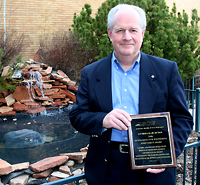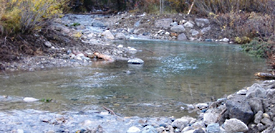
|
CONNECTIONS
|
IDAHO
ITD
HOME
IDAHO DMV
ITD
NEWS
HIGHWAY
SAFETY
IDAHO STATE
POLICE
TRAVEL SERVICES
STATE OF IDAHO
NATIONAL
AASHTO
AAMVA
AAA of IDAHO
FEDERAL HIGHWAYS
FEDERAL AVIATION
IDAHO STATE POLICE
NHTSA
NTSB
TRB
U.S. DOT
Idaho
Transportation
Department
Public Affairs Office
P.O. Box 7129
Boise, ID 83707
208.334.8005
Fax: 208.334.8563
Email


Reese's
hydrology, engineering expertise
pays dividends for migrating fish
Lotwick Reese was in high school when he noticed construction crews building U.S. 89 in front of the family farm near Bloomington in the Bear Lake Valley. He was so intrigued by the work that he asked about a job with the Idaho Department of Highways.
A half-century later, with retirement qualifications met – and surpassed – Reese has been honored for one of his greatest professional accomplishments. The American Society of Civil Engineers, southern Idaho section, presented Reese and several partners with an outstanding civil engineering achievement award for their work to restore historic fish passages in District 6.
 Sen.
Mike Crapo was instrumental in securing federal funds and expediting
the project that enables revered Yellowstone Cutthroat Trout to migrate
from Henrys Lake up Targhee and Howard creeks to their natural spawning
habitat.
Sen.
Mike Crapo was instrumental in securing federal funds and expediting
the project that enables revered Yellowstone Cutthroat Trout to migrate
from Henrys Lake up Targhee and Howard creeks to their natural spawning
habitat.
Reese is a licensed professional engineer. As the state hydrology engineer for ITD, he is charged with reviewing and approving water-related projects such as bridges and culverts. He was involved, along with Bev Shannon and Matt Farrar, in choosing bridge designs that would enable fish to migrate upstream. Gone are the arched pipe and culverts.
In their place is a 38-foot span across Howard Creek and an 80-foot clear span structure over Targhee Creek.
The most visible influence Reese had on the project may be the hardest to recognize.
Water that flowed under Idaho 87 in both streambeds dropped more than a foot into an artificially straight channel that flowed into Henrys Lake. The small waterfall that impeded fish movement now flows gradually into a meandering channel that includes a series of riffles and pools, creating a “fish-friendly” environment.
 The
new design, which more closely replicates the natural flow, includes
sands and gravels designed for stability and root wads, logs and other
natural amenities fish enjoyed before the culverts were installed.
The
new design, which more closely replicates the natural flow, includes
sands and gravels designed for stability and root wads, logs and other
natural amenities fish enjoyed before the culverts were installed.
“We are just trying to replicate what Mother Nature has known and has been doing for thousands of years – designing natural channels with meanders, riffles and pools that provide a friendly passage and home for the fish,” Reese explains.
Restoration of the natural channels was placed on a fast track early in 2005; design work was completed in late May or early June, Reese said, and construction was substantially completed by the end of the year. Formal completion of the new bridges and restored fish migration route was celebrated in June 2006.
Reese was not alone in sharing accolades for the project. ITD’s Bridge Section, District 6 and GeoEngineers of Boise also were honored, as were the project partners: Henrys Lake Foundation, Henrys Fork Foundation, the Caribou and Targhee national forests, the Idaho Department of Fish and Game and a number of other state and federal agencies.
 Although
it was one of Reese’s crowning achievements in nearly 30 years
with ITD, it is far from his last. He has about 10 active hydrology
projects on the table, representing work in all six districts of the
state. He also provides training on a regular basis to design engineers
in the districts and at Headquarters.
Although
it was one of Reese’s crowning achievements in nearly 30 years
with ITD, it is far from his last. He has about 10 active hydrology
projects on the table, representing work in all six districts of the
state. He also provides training on a regular basis to design engineers
in the districts and at Headquarters.
In addition to his tenure at ITD, which has come in several blocks of service, Reese, 68, also worked several years in the private sector as a consulting engineer in Logan, Utah, several years with the Federal Highway Administration in California, Oregon and Washington D.C. and about a dozen years with the Idaho Department of Water Resources as its engineering section supervisor.
His ITD career began on a survey crew on May 1, 1956, while he was still in high school. He began in a full-time capacity in 1958 as the Montpelier Residency office manager.
Reese later returned to earn a five-year Bachelor’s of Engineering Science degree in Civil Engineering at Brigham Young University.

Photos: A new bridge over Howard Creek (top) and a reconstructed meandering streambed (upper right) assist Yellowstone cutthroat trout as they migrate to spawning grounds. The District 6 project included restoring the natural streambed of Targhee Creek (above left) and construction of a new Targhee Creek bridge (bottom photo).
Published 3-2-07